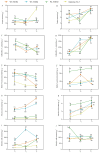The Physiological Basis of Alfalfa Plant Height Establishment
- PMID: 38475525
- PMCID: PMC10934537
- DOI: 10.3390/plants13050679
The Physiological Basis of Alfalfa Plant Height Establishment
Abstract
Plant height plays an important role in crop yield, product quality, and cultivation management. However, the physiological mechanisms that regulate the establishment of plant height in alfalfa plants remain unclear. Herein, we measured plant height traits, leaf characteristics, photosynthetic physiology, cell wall composition, and endogenous hormone contents of tall- and short-stalked alfalfa materials at different reproductive periods. We analyzed the physiology responsible for differences in plant height. The results demonstrated that the number of internodes in tall- and short-stalked alfalfa materials tended to converge with the advancement of the fertility period. Meanwhile, the average internode length (IL) of tall-stalked materials was significantly higher than that of short-stalked materials at different fertility periods, with internode length identified as the main trait determining the differences in alfalfa plant height. Leaf characteristics, which are closely related to photosynthetic capacity, are crucial energy sources supporting the expression of plant height traits, and we found that an increase in the number of leaves contributed to a proportional increase in plant height. Additionally, a significant positive correlation was observed between plant height and leaf dry weight per plant during the branching and early flowering stages of alfalfa. The leaves of alfalfa affect plant height through photosynthesis, with the budding stage identified as the key period for efficient light energy utilization. Plant height at the budding stage showed a significant positive correlation with soluble sugar (SS) content and a significant negative correlation with intercellular CO2 concentration. Moreover, we found that alfalfa plant height was significantly correlated with the contents of indole-3-acetic acid in stem tips (SIAA), gibberellin A3 in leaves (LGA3), zeatin in stem tips (SZT), and abscisic acid in leaves (LABA). Further investigation revealed that SS, SIAA, and LGA3 contents were important physiological indicators affecting alfalfa plant height. This study provides a theoretical basis for understanding the formation of alfalfa plant height traits and for genetic improvement studies.
Keywords: endogenous hormones; leaf characteristics; photosynthetic physiology; plant height traits; reproductive period.
Conflict of interest statement
The authors declare no conflicts of interest.
Figures









References
-
- Ju F.Y., Liu S.D., Zhang S.P., Ma H.J., Chen J., Ge C.W., Shen Q., Zhang X.M., Zhao X.H., Zhang Y.J., et al. Transcriptome analysis and identification of genes associated with fruiting branch internode elongation in upland cotton. BMC Plant Biol. 2019;19:415. doi: 10.1186/s12870-019-2011-8. - DOI - PMC - PubMed
-
- Marois J.J., Wright D.L., Wiatrak P.J., Vargas M.A. Effect of row width and nitrogen on cotton morphology and canopy microclimate. Crop Sci. 2004;44:870–877. doi: 10.2135/cropsci2004.8700. - DOI
Grants and funding
LinkOut - more resources
Full Text Sources

